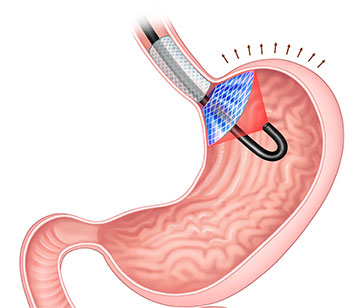
An intragastric implant (blue and gray) creates a feeling of fullness by pressing on the stomach and, when activated by a fiber-optic laser (black), kills cells that produce the hunger hormone ghrelin. [Image: Adapted from Lee et al., ACS Appl. Mater. Interfaces, doi: 10.1021/ACSAMI.2C00532]
Obesity is a global health concern that can lead to a wide range of diseases, such as type 2 diabetes, hypertension, stroke and cancer. In addition to improved diet and exercise, treatment for obesity may involve bariatric surgery and gastric implants.
Now, researchers in the Republic of Korea report promising test results of a new, minimally invasive nonsurgical device for weight loss. The intragastric satiety-inducing device (ISD) presses against the top part of the stomach, triggering a sense of fullness, and is coated with a light-activated dye that kills some of the cells that make the so-called hunger hormone, ghrelin (ACS Appl. Mater. Interfaces, doi: 10.1021/ACSAMI.2C00532).
Results from demonstrations in pigs showed a twofold reduction in weight gain and lower ghrelin levels one week after the treatment with the effects tapering off thereafter. With further development, the researchers say their photodynamic ISD could provide a less invasive alternative to bariatric surgery and implants in treating obesity.
Enhancing device performance with light
In 2019, researchers led by Hwoon-Yong Jung and Jung-Hoon Park of Asan Medical Center, Republic of Korea, published data on their initial ISD design: A stent implanted in the lower esophagus attached to a flexible disk placed just inside the stomach. According to the earlier report, the stent successfully slowed weight gain in pig models by continuously pushing against the area of the stomach that produces ghrelin. However, the decelerated weight gain was accompanied by complications like acid reflux and device migration.
For the 2022 ISD redesign, the team aimed to improve device efficacy and reduce complications by using a different, light-based approach to targeting ghrelin. The new ISD, which is only in the stomach for a few minutes, now includes a thin fiber-optic laser and a flexible disk coated in methylene blue—a common histology dye. When exposed to light from the laser, the methylene blue oxidizes, creating a reactive oxygen species (ROS) that rapidly kills some of the ghrelin-producing cells in contact with the coated disk.
After optimizing device design and ROS toxicity in vitro, the researchers conducted in vivo demonstrations in young pigs.
ISD in action
For the in vivo demonstrations, the researchers anesthetized young pigs and inserted the ISD into their stomachs. Once in place, the methylene blue-coated disk was hit with a 644-nm laser for 800 seconds (200 seconds per disk quadrant). Unlike the original ISD that remained implanted in the stomach, the new device was removed immediately after the photodynamic therapy.
Pigs that underwent the new ISD procedure showed slower weight gain than an untreated pig. Comparing the pigs’ total body-weight gain percentages, the treated pigs displayed smaller gain than the control pig for one week (12% vs. 24%), two weeks (28% vs. 42%), three weeks (58% vs. 78%) and four weeks (81% vs. 106%) post-treatment. Ghrelin levels in the blood of the treated pigs were lower compared with that of the untreated pig one and two weeks post-treatment and returned to normal after week three, suggesting the device’s effect would not last long-term.
The researchers concluded that ISD treatment effects could be maintained with repeated procedures and that with further development, the device could be used as a simple, minimally invasive procedure to help obese patients lose weight.
